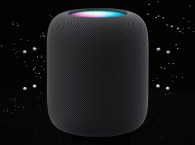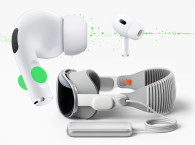Chris Stringer is a longtime Apple designer and the reason why the unveiling of its latest project caused so much buzz on the usual gadget-oriented click-bait websites. His new company is called Syng and its first product is called the Cell Alpha Triphonic Speaker. A mysterious designation to describe a lot of very ambitious technologies and a bold design that normally would makes us suspicious, if it wasn't for the fact that a lot of great names in speaker engineering are involved - and we understand that they couldn’t really tell us much more for now. And since there are no trade shows…

Apparently, the new audio company became a reality two years ago, even if the concept was in the works before that. The result of that work from an international engineering team, with collaborations from recognized industry veterans in all aspects of development, is the Syng Cell Alpha, dubbed "the world’s first Triphonic speaker." The designation, plus a website presentation left us with more questions than answers, but since so many experienced industry professionals were involved, I decided to request official information.
Unfortunately, it seems that the Syng team is still lacking on the marketing side and they unveiled the speaker but forgot to hire someone to write the press releases - meaning we received a PDF brochure that basically says the same things that are already on the website and published on the above-mentioned tech-garbage websites. Including a lot of statements like "Triphonic audio is super spatial sound" and references to a "groundbreaking new object-based sonic architecture that allows you to hear, see and touch sound, offering full control with precise placement and localization."
Since it seems that Dolby wasn't involved with Syng and there's no reference to MPEG-H audio standards, this must mean that Syng invented a new object-based audio format, which also means we have no way to understand how it will interpret source material mixed for any of the existing formats. In other words, more marketing hype to inflame the "spatial audio" muddle, even though their patent says the solution supports higher order ambisonics; Vector Based Amplitude Panning (VBAP); Distance Based Amplitude Panning (DBAP); and K Nearest Neighbors Panning. TBC

So, for this article I will try not to amplify the references to sounds "we can touch," or to the "field of sound," and I will focus more on the details about the Syng Cell Alpha, which seems to combine a lot of interesting things: completely new transducers, a new electroacoustic arrangement, and integration as a network-connected speaker. At first impression, it appears to be more of an "Echo Studio-killer” or - who knows - the greatest revolution in home audio since the Klipsch Horn.
There will be a lot to explore on the software side. The Syng Cell Alpha is controlled by an iPhone app, and we specifically mention the iPhone because apparently the controlling app makes use of Apple's ARKit to map out a room and generate immersive audio specifically for the environment and the source application. Important to note in this context that Christopher Stringer worked for Apple during 21 years and left in 2017 to create Syng. He was involved directly in developments for the iPhone and iPad, Apple Watch, and more importantly the HomePod. His name is referenced on more than 1,400 US patents.

The Cell Alpha hardware part is truly interesting since this is a three-horn circular system (“Triphonic”) that projects sounds "with pinpoint accuracy." The intriguing part about the software is that the patent claimed by Syng - titled “Systems and Methods for Spatial Audio Rendering” - describes "a plurality of sets of drivers, where each set of drivers is oriented in a different direction," and the response of those drivers being controlled by "an audio player application, wherein the audio player application configures the processor system" and "spatially encode the audio source, decode the spatially encoded audio source to obtain driver inputs for the individual drivers."
The spherical shape - which is shown as a transparent device on the website - reveals top and bottom woofers. The pair of opposing "Force-Balanced Subwoofers" use a triaxial carbon fiber weaver diaphragm that generates directional audio using modal beamforming. The bottom diaphragm surrounds the pole mount aperture for the speaker stand - which is not optional. In the meridian of the sphere we can see three high-frequency drivers directly coupled to the dispersion system, which are able to be configured to project sound “with unrivaled precision.” On the website there’s a reference to a “Single Point Source.”
In total, the Syng Cell Alpha sphere holds eight custom drivers, so we are still missing three. The answer for the remaining number of drivers lies in the fact that the Triphone three-horn system is actually powered by separate mid-frequency drivers and tweeters. The response is completely controlled by the built-in DSP processor, in any of the modes.

The official "press kit" PDF says that the Triphonic technology was optimized for Syng's new "object-based sonic architecture," which allows it to be placed everywhere as a single speaker or in multiple "cells." As the brochure states, "As you add more Cells to your home, you unlock new levels of spatial control and possibility."
We know very little about the electronics of the Syng Cell Alpha speaker but thanks to a few companies that know what a press release is, we learned that the new design is powered by last generation Class-D modules that use gallium nitride (GaN) power semiconductors. The use of these transistors - from GaN Systems - supports the extreme performance levels required by the multi-driver configuration, while allowing significant weight reductions and generating minimal heat.
"This type of challenge is a fitting application for GaN Systems transistors, which offer unparalleled switching performance in an extremely small package. This collaboration highlights the growing use of GaN in the audio market, from amplifiers to companion power supplies," GaN Systems states.
Each Syng Cell Alpha retails for $1,799 with a table stand or $1,969 with a floor stand. The multiple Cells can work together in any number, supporting both wired and wireless (AirPlay 2) connections. Wired connections include two USB-C ports which will support multiple applications, including Ethernet, USB audio streaming, and HDMI eARC for home theater modes.
The Syng Space app is used to manage the Cell speakers and will support Spotify integration, even though Spotify is the only streaming service that is yet to confirm what it intends to do with spatial audio, if anything. audioXpress will look forward to listening to this system and eventually publish a full review, after everyone else is done with the available demo units.
www.syngspace.com

This article was originally published in The Audio Voice newsletter, May 27, 2021 (#329). Click to register to The Audio Voice







